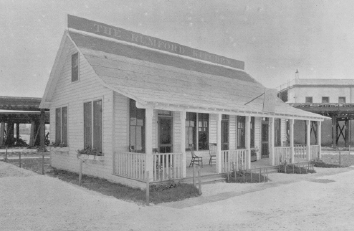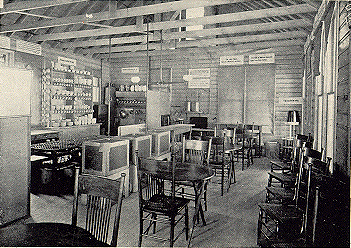The Massachusetts Board of World's Fair Managers, recognizing the high scientific character of the work of the New England Kitchen over which these ladies preside, and believing that such a practical demonstration of the usefulness of domestic science could not fail to be of advantage to multitudes of visitors to the Columbian Exposition, invited Mrs. Richards and Mrs. Abel to open the Rumford Kitchen, as it is called, as a part of the exhibit of Massachusetts, in connection with the Bureau of Hygiene and Sanitation.
In order to reduce, in some degree, the expenses of the exhibit, the food cooked in the Rumford Kitchen was sold under a concession from the administration of the Exposition; but it should be understood that it was not in any sense a money-making exhibit; that nothing was cooked for the sake of being sold; and that the exhibit was absolutely a scientific and educational one.
The Board refers with great pleasure to the very interesting report of Mrs. Richards which follows, and takes great satisfaction in the interest which this exhibit, endorsed as it was by the Commonwealth of Massachusetts, awakened among the visitors from all parts of the world. The Board is confident that the results following the expenditure of State money for the purpose of making known the scientific work done by Mrs. Richards and those associated with her must of necessity be far-reaching and tend to popularize the very great importance of the subject to which it related.
Boston, Dec. 27, 1893.
The Massachusetts Board of World's Fair Managers, Sears Building, Boston.
Sirs:--At your request, I beg leave to submit the following report, having to do with the exhibit made under your auspices under the name of the "Rumford Kitchen."
 |
From Report of the Massachusetts Board of World's Fair Managers, 1894 |
The removal of the Bureau of Hygiene and Sanitation, late in the season, from the Liberal Arts to the Anthropological Building necessitated an entire change of plans in regard to this exhibit. Space thirty by forty feet was secured near the south door of the Anthropological Building, and on this was placed a one-story frame structure finished as one room. The cost of the house was $700; that of the drainage, which was not at all planned for by the Exposition authorities in laying out that part of the grounds, was $429.87. The house not being ready by the 1st of August, it became necessary to send everything by express. On the other hand, the labor incident to the erection of this building was very much less than it would have been earlier in the season. The expense of the fittings and installation, including models, charts, china, filters, etc., was $1,822.38, of which sum $136.91 was for express alone. The total expense connected with this exhibit, including wages, the cost of food, gas, ice and other incidentals, amounted to $6,111.37. The total receipts from all sources, including sale of food and sale of plant at the end of the Exposition, amounted to $4,515, leaving a deficit of $1,596.37. From the receipts for sale of food there was paid to the authorities the sum of $890.63, the same being thirty per cent. of the gross receipts. Contributions from public-spirited citizens, amounting to $1,900, were made for the exhibit. The apparatus and a part of the furniture was sold to the University of Chicago for $250. The china is at present stored. The house remains intact, there being a possibility that something may be obtained for it, it being in such shape as to be readily removed and fitted for a dwelling. The models and photographs which awakened so much interest have been removed to Boston, and a large portion of the printed matter calling attention to the kitchen and the work done in connection therewith, was left at Hull House, the College Settlement in Chicago, for further distribution, the balance of which was returned to Boston, being still in constant demand.
The intention of the exhibit was to illustrate the present state of knowledge in regard to the composition of materials for human food, the means of making these materials most available for nutrition, and the quantity of each necessary for a working ration. It was also in part intended as a centennial celebration of the services to humanity of a man of Massachusetts birth and parentage, Benjamin Thompson, Count Rumford of Bavaria, the first to apply the term "science of nutrition" to the study of human food, and the first to apply science to the preparation of food materials.
Not the least valuable part of the exhibit consisted of the series of pamphlets prepared for the Rumford Kitchen by authorities in the several departments of science which relate to human food and nutrition. That such men as Professors Remsen and Abel of Johns Hopkins University, Professor Chittenden of Yale University, Professor Sedgwick of the Institute of Technology, Professor Howell and others were willing to prepare these scientific papers shows a great step toward placing this branch of sanitary science in its rightful place.
This series is not yet quite complete, though it will finally appear in book form as a permanent result of the Chicago Exposition.
 |
From Report of the Massachusetts Board of World's Fair Managers, 1894 |
The charts, diagrams and books of the exhibit were studied with great eagerness and cannot but have given impetus to the investigations in these directions; while the practical outcome of the taste and relish of the food served was shown in the fact that some ten thousand people were served during the two months that the kitchen was open, between the hours of twelve and two only, in a space so small as to permit only thirty people to be seated at the same time.
In order to emphasize the facts above narrated, the food was served in portions containing a definite amount of nutrition, and the menu card on each table gave the requirement for one-quarter of one day's ration, with the weight and composition of each dish composing the meal. A choice of two or three luncheons, for which the price was thirty cents, was given each day, each containing three or four dishes, though an extra price was made for a glass of milk, for a cup of cocoa, tea or coffee.
The results which go to testify that this exhibit was a recognized success are already apparent. The entire plant of the exhibit was put into the experimental kitchen of the Woman's Dormitories in connection with the University of Chicago, which is now in Miss Daniell's charge, and the work has attracted so much attention that not only has the great hospital for the insane at Kankakee, Ill., already secured the services of the manager of the Boston Kitchen, but the institutions and universities of our own State are coming to the kitchen as to headquarters.
I take pleasure in saying that the successful carrying out of the plan adopted is largely due to the interest taken in and the energy given to the Rumford Kitchen by its manager, Miss Maria Daniell of Boston, and by Mr. Arthur R. Wilmarth of Jamaica Plain.
I remain, very respectfully,
Ellen H. Richards
Tributes after her death | Publications by and about Ellen Swallow Richards
August 1999
Return to Ellen Swallow Richards
Return to Archives